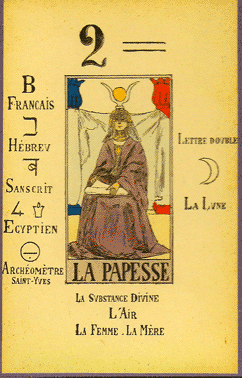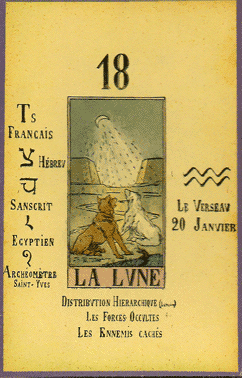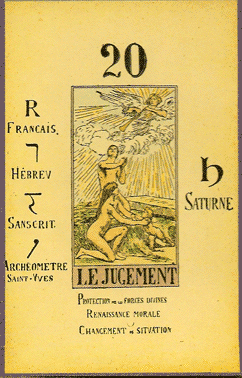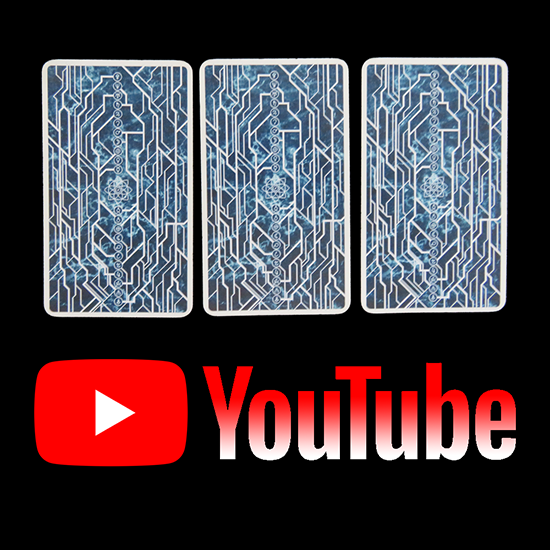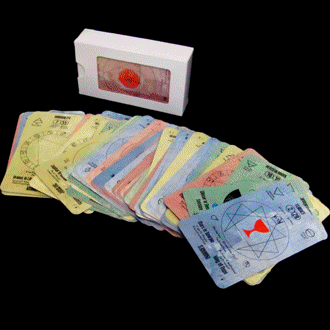Gérard Anaclet Vincent Encausse (July 13, 1865 – 25 October 1916), whose esoteric pseudonym was Papus, was the Spanish-born French physician, hypnotist, and popularizer of occultism, who founded the modern Martinist Order.
As a young man, Encausse spent a great deal of time at the Bibliothèque Nationale studying the Kabbalah, occult tarot, magic and alchemy, and the writings of Eliphas Lévi. He joined the French Theosophical Society shortly after it was founded by Madame Blavatsky in 1884 – 1885, but he resigned soon after joining because he disliked the Society’s emphasis on Eastern occultism.
In 1888, he co-founded his own group, the Kabbalistic Order of the Rose-Croix. That same year, he and his friend Lucien Chamuel founded the Librarie du Merveilleux and its monthly revue L’Initiation, which remained in publication until 1914.
Encausse was also a member of the Hermetic Brotherhood of Light and the Hermetic Order of the Golden Dawn temple in Paris, as well as Memphis-Misraim and probably other esoteric or paramasonic organizations, as well as being an author of several occult books. Outside of his paramasonic and Martinist activities he was also a spiritual student of the French spiritualist healer, Anthelme Nizier Philippe, “Maître Philippe de Lyon”.
Despite his heavy involvement in occultism and occultist groups, Encausse managed to find time to pursue more conventional academic studies at the University of Paris. He received his Doctor of Medicine degree in 1894 upon submitting a dissertation on Philosophical Anatomy. He opened a clinic in the rue Rodin which was quite successful.
Encausse visited Russia three times, in 1901, 1905, and 1906, serving Tsar Nicholas II and Tsarina Alexandra both as physician and occult consultant. Although Encausse seems to have served the Tsar and Tsarina in what was essentially a shamanic capacity, he was later curiously concerned about their heavy reliance on occultism to assist them in deciding questions of government. During their later correspondence, he warned them a number of times against the influence of Rasputin.
Encausse’s early readings in tarot and the lore of the Kabbalah in translation was inspired by the occult writings of Eliphas Lévi, whose translation of the “Nuctemeron of Apollonius of Tyana” printed as a supplement to Dogme et Rituel de la Haute Magie (1855), provided Encausse with his nom de plume: “Papus” means “physician.”
In 1891, Encausse claimed to have come into the possession of the original papers of Martinez Paschalis, or de Pasqually (c. 1700-1774), and therewith founded an Order of Martinists called l’Ordre des Supérieurs Inconnus. He claimed to have been given authority in the Rite of Saint-Martin by his friend Henri Vicomte de Laage, who claimed that his maternal grandfather had been initiated into the order by Saint-Martin himself, and who had attempted to revive the order in 1887. The Martinist Order was to become a primary focus for Encausse, and continues today as one of his most enduring legacies.
In 1893, Encausse was consecrated a bishop of l’Église Gnostique de France by Jules Doinel, who had founded this Church as an attempt to revive the Cathar religion in 1890. In 1895, Doinel abdicated as Primate of the French Gnostic Church, leaving control of the Church to a synod of three of his former bishops, one of whom was Encausse.
In March 1895, Encausse joined the Ahathoor Temple of the Hermetic Order of the Golden Dawn in Paris.
Although Encausse claimed as his “spiritual master” the mysterious magician and healer known as “le Maitre Philippe” (Philippe Nizier), his first actual teacher in the intellectual aspects of occultism was the marquis Joseph Alexandre Saint-Yves d’Alveydre (1842 – 1910). Saint-Yves had inherited the papers of one of the great founders of French occultism, Antoine Fabre d’Olivet (1762 – 1825), and it was probably Saint-Yves who introduced Papus to the marquis Stanislas de Guaita (1861 – 1897).
In 1888, Encausse, Saint-Yves and de Guaita joined with Joséphin Péladan and Oswald Wirth to found the Rosicrucian Kabbalistic Order of the Rose-Croix.
In October 1901 Encausse collaborated with Jean Carrère in producing a series of articles in the Echo de Paris under the pseudonym Niet (“no” in Russian). In the articles Sergei Witte and Pyotr Rachkovsky were attacked, and it was suggested that there was a sinister financial syndicate trying to disrupt the Franco-Russian alliance. Encausse and Carrère predicted that this syndicate was a Jewish conspiracy, and the Anti-Zionist nature of these articles, compounded by Encausse’s known connection to the Tsar of Russia, may have contributed to the false allegation that Papus was the author who forged The Protocols of the Elders of Zion.
Encausse never became a consistent (Grand Orient) Freemason. Despite this, he organized what was announced as an “International Masonic Conference” in Paris on June 24, 1908, and at this conference he first met Theodor Reuss, and the two men apparently exchanged patents:
Reuss elevated Encausse as X° of the Ordo Templi Orientis as well as giving him license to establish a “Supreme Grand Council General of the Unified Rites of Ancient and Primitive Masonry for the Grand Orient of France and its Dependencies at Paris.” For his part, Encausse assisted Reuss in the formation of the O.T.O. Gnostic Catholic Church as a child of l’Église Gnostique de France, thus forming the E.G.C. within the tradition of French neo-gnosticism.
When John Yarker died in 1913, Encausse was elected as his successor to the office of Grand Hierophant (international head) of the Antient and Primitive Rites of Memphis and Mizraim. (Source: Wikipedia)

A modern, black and gold re-rendering of the deck is available now on IndieGoGo: https://igg.me/at/papus/



